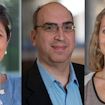
J. Elliott Robinson is an M.D./Ph.D. trained scientist and an assistant professor in the Department of Pediatrics at Cincinnati Children’s Hospital and the University of Cincinnati College of Medicine. Robinson is a 2019 fellow of SFARI’s Bridge to Independence (BTI) Award program, a grant program that provides funding and career mentoring to early-career scientists to support the transition to independent academic research positions. Robinson is also one of the first recipients of the recently launched SFARI Supplement to Enhance Equity and Diversity (SEED) program, an initiative that provides supplements to existing grants to aid in the recruitment of new postdoctoral students from American underrepresented minority groups to grantee laboratories.
Robinson started his own laboratory in July 2020, studying how neural circuits for motivation and attention are affected in neurodevelopmental conditions, with a particular focus on neurofibromatosis type 1 (NF1) — a condition caused by mutations in the autism risk gene neurofibromin 1 (also referred to as NF1). Individuals with NF1 mutations develop benign and malignant tumors that affect skin, bone, eye and nervous system function, with nervous system dysfunction leading to issues in executive functioning, attention and spatial learning. To understand how motivation and attention circuits are affected in NF1, Robinson’s laboratory employs a range of advanced molecular and imaging techniques, including the use of genetically encoded calcium and neurotransmitter sensors, optogenetic tools and adeno-associated viral vector (AAV) technologies. The laboratory is also using new systemic AAV vectors to explore potential gene therapies for NF1 and related neurodevelopmental conditions.
I recently spoke with Robinson to learn more about his laboratory’s work to and to discuss how the BTI and SEED Awards are helping to shape his research career.
The interview has been edited for clarity and brevity.
Your laboratory studies how motivation and attention circuits are affected in the neurodevelopmental condition neurofibromatosis type 1 (NF1), and you also work extensively with viral vectors for gene therapy applications. What career path led you to this research?
Following pre-medical studies at Georgetown University, I spent a year between undergraduate and medical school doing research at the National Institute on Alcohol Abuse and Alcoholism (NIAAA) with Markus Heilig. Heilig was the clinical director of NIAAA at the time, and his lab worked to develop pharmacotherapeutics for alcohol dependence. That year, I became very interested in psychopharmacology and the neurobiology of motivated behavior, which I continued to study as member of the Medical Scientist Training Program at the University of North Carolina (UNC) at Chapel Hill. At UNC, I worked with C.J. Malanga (now at Takeda), a child neurologist who was interested in the basal ganglia and the role of dopamine in reward and motivation. During my doctoral training, I continued to collaborate with Heilig to examine the role of a prominent mu opioid receptor gene polymorphism (A118G) in alcohol and opioid dependence using a humanized mouse model. This work also featured collaboration with Bryan Roth at UNC, who helped us utilize high throughput pharmacological assays to assess the A118G polymorphism at the receptor level.
“I was struck by the high rates of attention-deficit/hyperactivity disorder (ADHD) in children with NF — roughly ten times that seen in the neurotypical population. That got me very interested in trying to understand the biology of NF using modern techniques for systems neuroscience research. ”
- J. Elliott Robinson
Following graduate training, I returned to medical school for clinical rotations and discovered a love of pediatrics and child neurology. My clinical mentor, Robert Greenwood, the Chief of Child Neurology at UNC at that time, ran the Comprehensive Neurofibromatosis (NF) clinic at UNC. Working in his clinic, I was struck by the high rates of attention-deficit/hyperactivity disorder (ADHD) in children with NF — roughly ten times that seen in the neurotypical population. That got me very interested in trying to understand the biology of NF using modern techniques for systems neuroscience research. While several papers suggested that developmental perturbations in dopaminergic circuits were causing ADHD phenotypes in NF1 mouse models, no one had ever measured dopamine release or dopamine circuit activity in awake, behaving mice. Supported by a Children’s Tumor Foundation Young Investigator Award, I decided to forego residency and pursued postdoctoral work with Viviana Gradinaru at Caltech (California Institute of Technology). There, I worked on attentional and cognitive deficits in NF1 model mice using novel technologies developed by Viviana’s lab and collaborators, including new systemic AAV (adeno-associated virus) vectors that freely cross the blood-brain barrier after intravenous administration
What research questions are you exploring in your laboratory at Cincinnati Children’s Hospital, and what approaches are you using to tackle these questions?
My lab has two main areas of focus. One is on neural circuits involved in attention and cognitive function, where we look at things like salience and decision-making in NF1 mouse models using calcium imaging and neurotransmitter sensors, optogenetics, electrophysiology and viral vector-based circuit mapping techniques. Our other interest is on further development of AAV gene therapy tools to restore normal brain function in NF1 and other RASopathies.
Coming to Cincinnati Children’s Hospital was a great opportunity, as it has considerable research infrastructure dedicated to the study of RASopathies, including NF1, from both a clinical and translational perspective. I work with people like Nancy Ratner, who has done foundational work that led to the development of FDA-approved MEK inhibitors for the treatment of plexiform neurofibroma in NF1e.g.
“We are now focused on deciphering which phenotypes are the most robust and repeatable so that we can use them to gauge the effectiveness of our therapies.”
- J. Elliott Robinson
You are an M.D./Ph.D. trained scientist, and your research has a strong translational approach. Would you tell us more about the efforts you are undertaking to find new genetic therapies for NF1 and related RASopathies?

For our gene therapy efforts, we’ve had to take a step back and identify the most robust set of core phenotypes that could serve as a read-out for the effects of our AAV gene therapy vectors. The cloning and design of these vectors is relatively straightforward. However, showing that they work is a much trickier beast. In looking over the literature on NF1, I realized that there are myriad phenotypes reported in Nf1 mutant mice but, in general, they are pretty subtle and not always easy to replicate from lab to lab — things like changes in behavior, dendritic spines, synaptic plasticity, RAS-MAP kinase cascade activation and so on. We are now focused on deciphering which phenotypes are the most robust and repeatable so that we can use them to gauge the effectiveness of our therapies. It also turns out that a lot of the systemic AAV capsids we use cross the blood-brain-barrier very efficiently in mice but are less effective in non-human primates. There are currently efforts from a number of groups to develop systemic AAVs that are optimized for primates, and we’re interested eventually using those new vectors as well.
NF1 is a known autism risk gene. What are the broader implications of your work for our understanding of, and potential treatments for, autism?
There’s a lot of interest in using AAVs for potential gene therapies across the autism spectrum, including in syndromic forms of autism. For haploinsufficiency conditions like NF1, where you still have one functional copy of the gene, boosting expression of the single functional copy with an AAV vector could potentially rescue the condition. While several molecular tools that modulate endogenous gene expression like CRISPR-mediated activation seem to be effective when large numbers of AAV particles are injected directly to the brain, making them work well with systemic AAV delivery — where the per cell copy number is lower — is challenging. As a result, we’re working with collaborators to optimize molecular technologies used by ASD researchers in gene therapy applications for use with systemic AAV delivery. We hope that AAV constructs designed for use in mouse models of NF1 could be easily adapted by other labs to target any other number of autism risk genes.
“The SFARI BTI and SEED funding have been hugely helpful in the recruitment of talented scientists to the lab by supporting their salaries. These extra personnel have been crucial in getting us to the point of producing.”
- J. Elliott Robinson
The research that you are doing in your laboratory is impressive, and particularly so given that you opened your laboratory this year during the ongoing COVID-19 pandemic. What challenges have you faced in getting your laboratory up and running, and how has your SFARI BTI Award helped in your transition to becoming an independent investigator?
Setting up during COVID was hard. I was on the job market in 2019 and signed an offer letter with Cincinnati Children’s Hospital in February 2020 with a July 2020 start date. I was all set to go back to the Gradinaru lab and spend six months generating data, and then the pandemic hit, and Caltech largely shut down. After spending the spring home schooling my children, I moved to Cincinnati and started my lab amidst supply shortages, equipment delays and restrictions in how and when we could do in person research. The slowdown did give me opportunities to do things like get animal and biosafety protocols written and approved, as well as submit several grants. In terms of the awards helping my transition, the SFARI BTI and SEED funding have been hugely helpful in the recruitment of talented scientists to the lab by supporting their salaries. These extra personnel have been crucial in getting us to the point of producing meaningful data without forcing me to burn through my start up. It’s taken a solid year, but I finally feel that we’re starting to fire on all cylinders in terms of research productivity.
You mention that you are a recipient of a SEED Award, a new SFARI program that provides up to three years of funding to SFARI grantees to help recruit a postdoctoral student from an underrepresented minority group. Could you speak about your experience with this process and the steps you took to identify a suitable candidate?
I’ve tried very hard to promote diversity, equity and inclusion in our laboratory, so I was very interested when the SFARI SEED program was announced at the BTI meetings. SFARI made the application streamlined, and we received their funding decision within a couple weeks, which is quite remarkable given the amount of financial support the program offers. One of the biggest advantages of the SEED program is that it aids postdoc recruitment by guaranteeing funding for candidates for three years. For me, this is really helpful given that it’s challenging in general to attract strong postdoctoral fellows when you’re a new investigator. It took some additional effort to recruit someone who would specifically meet the requirements of the SEED grant, but fortunately there are now many organizations and resources supporting the careers of minority or historically underrepresented groups in neuroscience, such as the Black in Neuro community, which makes outreach easier.
While I had posted some advertisements and worked with our Human Resources department to try to find applicants that would quality for SEED, I was ultimately able to recruit Evelin Cotella locally. Evelin has a robust skill set doing behavior, molecular biology and in vivo electrophysiology, so she’s been able to dive right in to get the in vivo validation aspects of our gene therapy project moving forward. In the future, I could also see space for SFARI to provide support for recruitment — something along the lines of establishing an online portal where interested candidates and SFARI investigators could both post their interest in participating in the program. I think this would be particularly helpful for recruiting diverse candidates to newer labs like my own.
You are also a SFARI BTI fellow. What have you found most valuable about the BTI Award, and are there additional efforts SFARI could undertake to further support BTI fellows?
Aside from the actual grant money, which is obviously hugely helpful, I have benefited the most from the interpersonal relationships that I’ve been able to establish as a BTI awardee. The networking opportunities afforded by annual BTI retreats have allowed me to form connections with other fellows and established researchers and have sparked collaboration. I’ve also found the interactions with senior investigators to be invaluable as I was facing the enormous task of setting up my own lab. I was able to pick their brains about regulatory hurdles, equipment costs and set-up, managing lab finances, hiring and managing your personnel and various other tasks required of a new investigator. My lab has made significant progress this last year, even with the time lost to COVID, and I’m thankful for all of the support from SFARI that helped make this possible.
References
- SFARI workshop explores challenges and opportunities of gene therapies for autism spectrum disorder
- SFARI Bridge to Independence fellows discuss new research findings and career challenges at virtual retreat
- SFARI announces 2019 Bridge to Independence Award fellows
- Small molecules, genes and antisense oligonucleotides: Industry perspectives on treatment development for ASD



